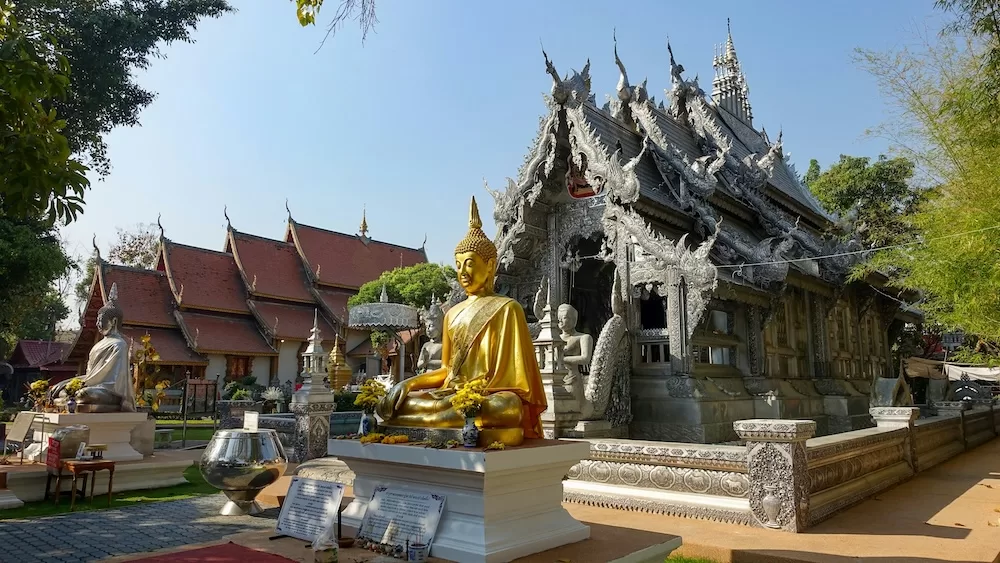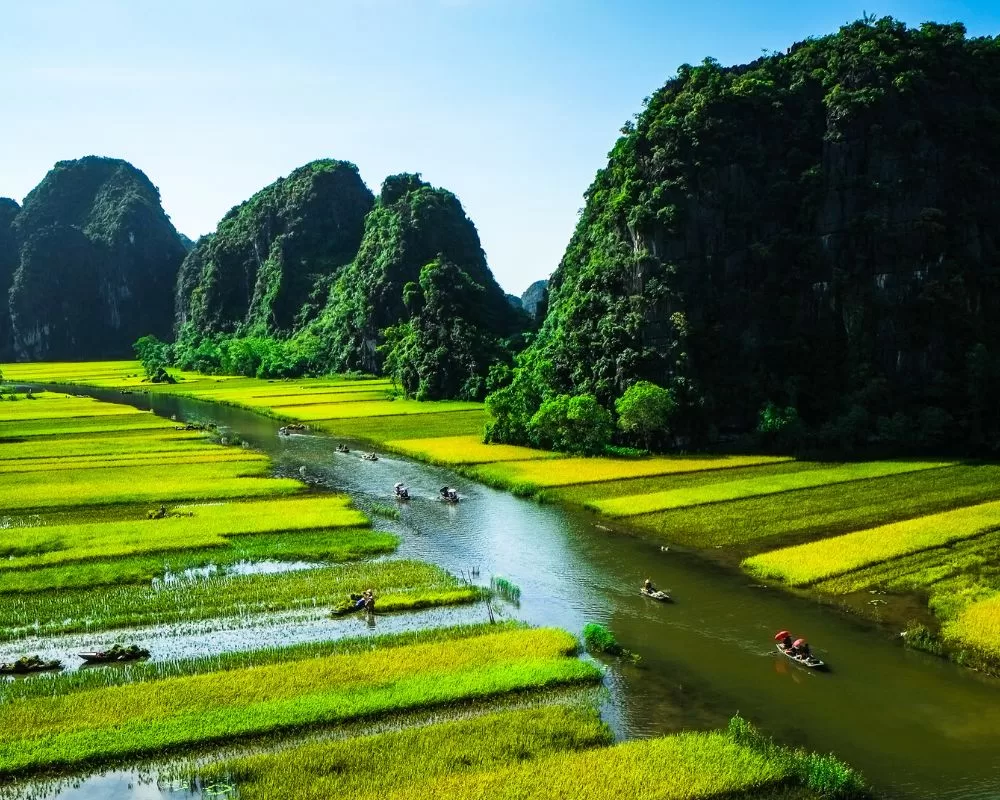
The Ultimate Guide To North Vietnam 2024
South Vietnam consists of busy and crowded cities like Ho Chi Minh and Mui Ne, whereas North Vietnam gives you the best places to see with more insight into the natural landscapes of Vietnam like the lavish rice terraces, high mountain ranges, and architectural buildings. These places offer travellers the opportunity to immerse themselves in the rich culture of the country, whilst experiencing a diverse range of natural attractions from astonishing beaches, golden rice fields, and imposing mountains to lakes, rivers and primeval forests.
Ultimate Guide to North Vietnam
- Visit Hanoi – The Home to Vietnamese Culture
- Indulge In The Beauty of Ninh Binh
- Cruise the 1,000 Islands and Islets of Ha Long Bay
- Explore Cat Ba Island
- Tour The Hang Sung Sot Cave
- Admire The Rice Fields
- Do Some Trekking In Sapa
- Experience The Ha Giang Loop
- Should You Self-Drive or Use an Easy-Rider?
- Indulge Yourself in Vietnamese Cuisine
- Discover North Vietnam’s History
- The Best Time to Visit North Vietnam
- Essential Travel Toolkit
Visit Hanoi – The Home to Vietnamese Culture
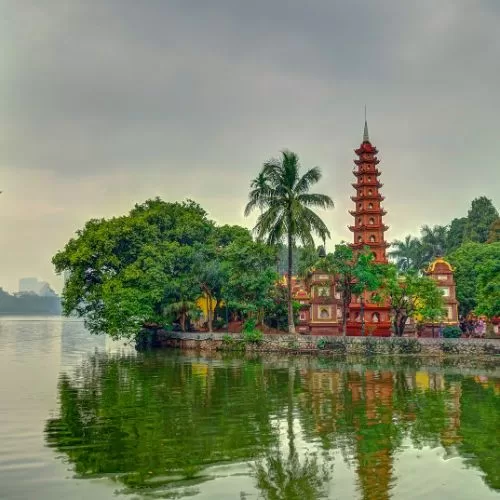
Named ‘Asia’s Leading City Break Destination’ for 2022 by the World Travel Awards, the country’s capital has so much to offer. Hanoi is Northern Vietnam’s not-to-be-missed destination. With a long history and traditional culture imbued with national identity, the capital is home to 3840 Vietnam’s valuable monuments, including 1164 national-level monuments. There are a large number of temples, pagodas and cathedrals in Hanoi. Some of the unmissable ones are Tran Quoc Pagoda, Ngoc Son Temple, Mot Cot Pagoda, Quan Su Pagoda, and Quan Thanh Temple, to name but a few. Inspired by Paris’s Notre Dame Cathedral, Hanoi’s St. Joseph’s Cathedral has an impressive Gothic architectural design, offering up yet another Instagrammable photo opportunity.
Start your trip here to get a feel for the country’s culture and history. Begin by strolling the Old Quarter, with its ancient shopping streets, French colonial architecture, souvenirs and street food. Delight in sampling regional dishes including bun cha (rice vermicelli noodles with barbequed pork), then take a wander around one of Hanoi’s 20 lakes to see how locals enjoy downtime. There’s a long history of traditional arts in and around Hanoi, so check out the nearby craft villages if that piques your interest.
Indulge In The Beauty of Ninh Binh
Once you have visited the captivating and historical corners of Hanoi, brace yourself for the enchanting scenery of Northern Vietnam in Ninh Binh. If a fantasy movie were made in Vietnam, it would most certainly be shot in Ninh Binh, a stunning destination about two hours from Hanoi. Be sure to visit Tam Coc (meaning ‘three caves’), which forms part of the Trang An Scenic Complex UNESCO World Heritage Site.
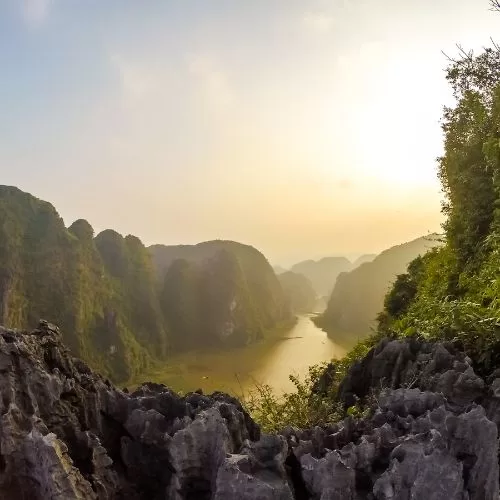
Ning Binh is blessed with spectacular limestone karsts that create dramatic scenery. you’ll feel humbled as you travel in between the spectacular rice fields, water-lily ponds and meandering waterways that create mesmerising scenes.
For a taste sensation that you can’t find anywhere else in Vietnam, Trang An Ninh Binh has some unique specialities. One of the most popular dishes is Rice crust, which is crunchy, tasty and fat. Dishes made from goat meat are also popular, such as goat hotpot, roasted goat, rare goat meat and steamed goat meat. There are other specialities such as boiled mountain snail, To Nhu vermicelli noodles, and Nho Quan wine to mention but a few.
Cruise the 1,000 Islands and Islets of Ha Long Bay
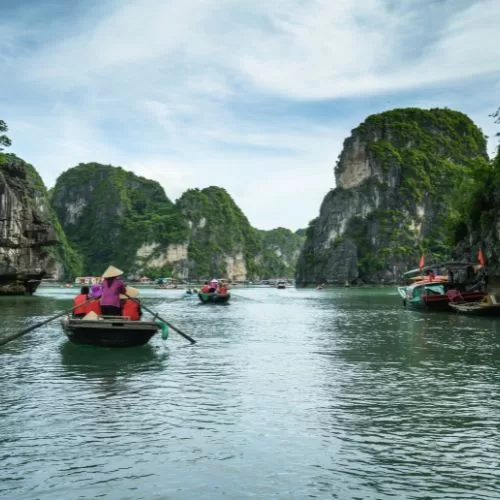
Recognized as a natural wonder of the world by UNESCO, Ha Long Bay in North Vietnam attracts travellers from all over who wish to experience dramatic limestone hills, forests, caves and bays that are easily explored.
There are a plethora of cruise tours on offer – cruises for a backpacker’s budget or for those ready to splurge on this bucket-list experience. Stay on board for a night or two to truly make the most of the setting, whether by snorkelling, visiting caves or floating fishing villages, or kayaking to teeny-tiny beaches for a swim.
Ha Long cuisine is something you should not miss out on when coming to Ha Long Bay, the specialities are a combination of fresh seafood and skilful processing techniques.
Banh Gat Gu (Nodding Cake): a roll made from rice powder with minced pork and fried onions.
Chao Ha (Acorn Barnacle Porridge): a dish with nutritious shellfish as the main ingredient.
Grilled Chopped Squid: a dish made of chopped or minced squid.
On land, Ha Long City is worth a short stop. Swim at one of the beaches, try out local seafood, or take a ride on the cable car or Ferris wheel of the Sun World Ha Long Complex.
Explore Cat Ba Island
Cat Ba Island, lying off the northeast coast of Vietnam in the Gulf of Tonkin, is a favourite travel destination for all tourists. Cat Ba Island is part of the world-famous Halong Bay and one of Vietnam’s star natural attractions.
Cat Ba Island offers those seeking adventure an opportunity to rock climb and hike, kayak and spelunk. Trung Trang Cave, located in Trung Trang Valley, represents more than 150 large and small caves in Cat Ba National Park, it is home to many altars and bats. Hikers can enjoy the trails within the UNESCO biosphere reserve which is the Cat Ba National Park. It includes dense forests, mangroves and wetlands, and the Ngu Lam Peak viewpoint.
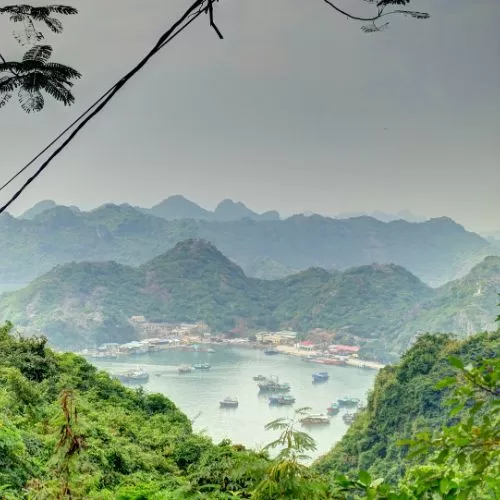
Tour The Hang Sung Sot Cave
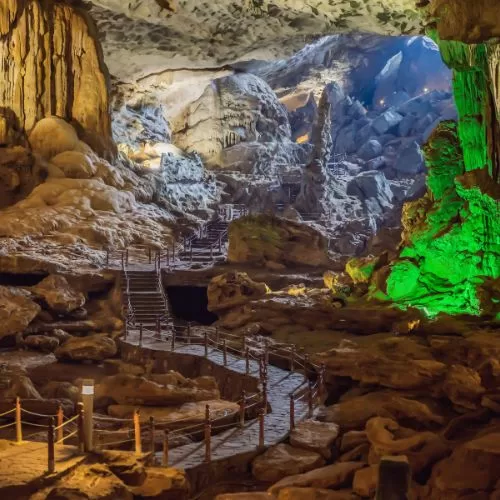
Among the 1,969 sunken limestone towers submerged in the indigo waters of Halong Bay are a series of ancient caves and grottoes – many of which remained unexplored. Of all of Halong’s caves, Sung Sot Cave is the largest, the most renowned, and the most visited of all. On the official registry, to date, are 59 caves listed, all of which have a special belonging to Halong Bay’s distinctive ecosystem. Undoubtedly, Sung Sot Cave has rightfully earned its near-legendary status among visitors to the world-famous bay.
Allegedly, Sung Sot Cave was first discovered by the French in 1901, who then took it upon themselves to name it “Grotte des Surprises”, or Surprising Cave, because of its ‘surprising’ beauty. However, the name didn’t catch on until a good 40 years later. The first visitors were welcomed to the cave in 1993, just one year before Halong Bay received its first bestowment of World Heritage site status from UNESCO.
You’ll likely kayak onto the island of Bo Hon Island where there’s a small dock at the bottom. Here you’ll have to climb up 100 or so steps to the mouth of Sung Sot Cave. The cave covers a staggering 10,000 square meters, is about 30 meters high and sports a 500-meter-long passage. Separated into 2 caverns, the interior has a small amphitheatre space connected by a small passageway to the larger cavern next door. This is big enough to hold 1,000 people or more! The entire cave is scattered with stalactites and stalagmites, which serve as endless material for the legend and ‘lore of the area.
Admire The Rice Fields
Perhaps nothing is more synonymous with Vietnam than its beautiful rice fields, which reflect spectacular shades of green when the rice is growing and turn a stunning yellow hue nearer harvest.
Head to SaPa, the ‘town of clouds’ in the remote northwest, to see these grand terraces and majestic mountain terrains. Amongst these fields, you’ll find fascinating and friendly ethnic minorities living in tiny hill tribe villages. They are welcoming to any visitors that stay in their charmingly rustic homestays. A homestay is an authentic travel memory you’ll never forget.

A thrilling and different vantage point to savour the splendour of these grand rice-field scenes is by paragliding over them. If you are visiting in September, make sure not to miss the paragliding festival at Mu Cang Chai, about 300km from Hanoi – a bucket-list experience of note.
Do Some Trekking In Sapa

Located at the foot of the Hoang Lien Son mountain range, Sapa is a tourism centre of Northern Vietnam with stunning natural landscapes. Sapa is famous for Mount Fansipan – the highest peak in Vietnam. Muong Hoa Valley is at the bottom of Mount Fansipan. It gained its reputation for majestic nature, breathtaking scenery and the diverse culture of many ethnic minorities. The highlight of this valley is the Ancient Stone Field, a unique destination where visitors learn more about local history.
Home to the H’Mong people, Cat Cat Village is an unmissable destination in Sapa. The rice terraces are cultivated by the local people, additionally, they make traditional crafts and tourists visit the village to buy their handicrafts as souvenirs. Another popular destination – Ham Rong Mountain is where you can see most of Sa Pa’s tourist attractions such as Muong Hoa Valley, Ta Van Village, and Cat Cat Village.
Sapa sits about 4,921 feet (1,500 meters) above sea level. The climate varies between moderately warm and rainy in summer and cool and foggy in winter. The best time to visit is during the climate sweet spot in the shoulder seasons, from September to November and from March to May. Aim to avoid visiting over the Tet (Lunar New Year) holiday, as with all Vietnamese tourist destinations.
Travelling to Sapa, you have a chance to discover many typical dishes of Northern Vietnam such as seven-colour sticky rice, grilled pork, grilled chicken, grilled duck, bamboo-tube sticky rice, dried buffalo meat and so much more! Sa Pa is a trifecta of breathtaking views, cultural diversity and a taste sensation.
Experience The Ha Giang Loop
Ha Giang Province is a lush mountainous region with an amazing landscape of limestone pinnacles and granite outcrops in northern Vietnam that borders China. To truly experience the rugged beauty of rural Vietnam, many say that riding the Ha Giang loop is the ultimate experience.
Taking you from Ha Giang City centre, the Ha Giang Loop heads across the Dong Van Karst Plateau to the Vietnam/China border and then back again. Along the way you will be immersed in lush mountain jungles, travel alongside meandering rivers and beneath towering mountains as you traverse their passes.
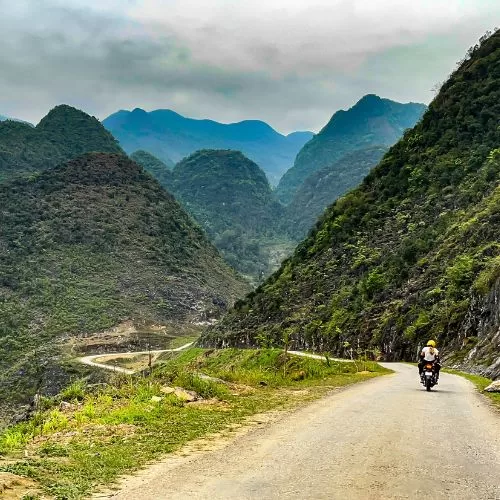
Should You Self-Drive or Use an Easy-Rider?
Self-Drive
If you have an international motorbike licence and are a very confident driver, then why not? For the most part, the roads are pretty well maintained, except for a few off-road sections. Be warned – in some sections, the roads can be very winding and fairly steep.
TIP: Do not self-drive without an international licence. There are reports of police checkpoints being set up with them asking to see people’s licences. If you do not have an international motorbike licence, they will take your motorbike. You might hear some travellers say they were never checked and that this is a ‘scare tactic‘ to make people choose to go on an Easy Rider Tour. However, this is not a scare tactic! You will get stopped almost immediately by the police as you leave Ha Giang City to do the loop.
Easy-Rider – Sitting Behind a Tour Guide
An easy and very safe option is doing the Ha Giang Loop with a driver. No need to worry about treacherous roads, steep inclines, winding roads, getting lost or not knowing where to eat. Your Ha Giang Loop guide will have all the stops, restaurants/food stalls and homestays already plotted. They do The Ha Giang Loop by scooter/motorbike for you .. you just need to sit back and enjoy the ride!
pssst. Did you see our post on traveller scams to watch out for in Southeast Asia?
The tour guides have done the Ha Giang Loop plenty of times and know it like the back of their hands – the likelihood of getting into any accidents or having any crashes is extremely low. Most guides have done the Ha Giang Loop over 150 times.
If you’ve travelled this far, head to Dong Van Karst Plateau Global Geopark which is located in the northeast province of Ha Giang. The Dong Van Karst Plateau Geopark encompasses four districts within Ha Giang Province and stretches over 2,356 square kilometres. Its extraordinary beauty and geological significance have earned it a place among the most captivating natural landscapes in Southeast Asia. Dong Van Rock Plateau is formed by narrow valleys alternating with rocky mountain ranges in the north of Vietnam. Dong Van Karst Plateau Geopark has a temperate climate which is divided into two seasons: rainy season (May – October) and dry season (November – April). The annual average temperature is 21 – 23ºC. It may get up to 27 – 28ºC in July and August and may drop down to below 0ºC in January.
Indulge Yourself in Vietnamese Cuisine
As the north, central, and south of Vietnam differ in terms of infrastructure, topography, and buildings, the delicious cuisine of Vietnam changes from region to region and the differences are rather noticeable. Standing as a unique pillar in the diverse culinary landscape of Vietnam, Northern Vietnamese food is unique in its elegance and simplicity, making it distinct from the flavours of other regions.
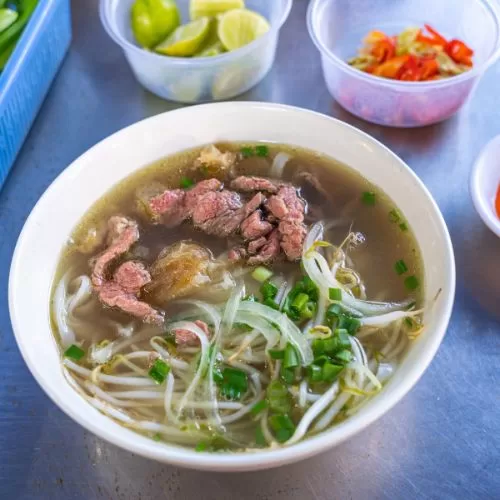
Northern Vietnam is the birthplace of many Vietnamese favourites such as phở, banh cuon and bun cha. The first two are breakfast staples and the latter is a lunchtime go-to. Phở is Vietnam’s national dish and the most well-known outside of Vietnam. It’s your typical noodle soup dish, made of three components: a flavorful broth, some kind of meat and delicious silky rice noodles. You can add in extra flavouring according to your taste.
Bun thang is a classic chicken noodle soup from Hanoi, famous for its finely chopped toppings. A typical bowl of bun thang contains roughly 20 ingredients, including vermicelli, bone broth, dried shrimp, shredded chicken, pickled beet, fried egg slices, and shiitake mushrooms. It is usually enjoyed with fermented shrimp sauce. Why not try a unique take on bun thang in Hung Yen Province called bun thang with eel?
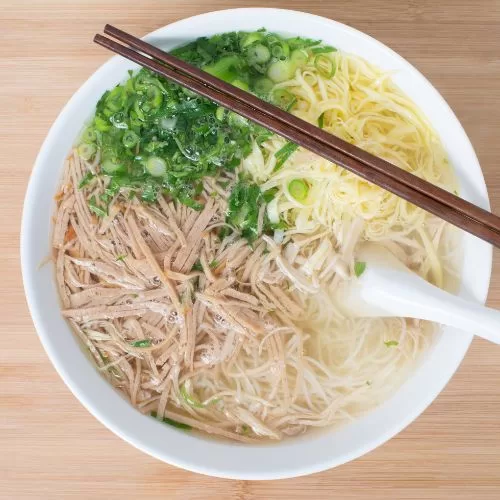
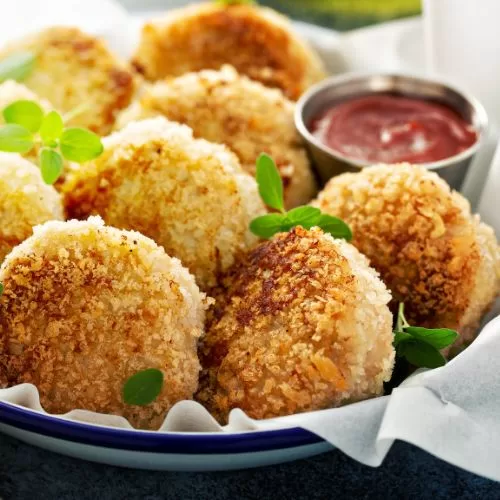
Regarded as one of the most special Vietnamese chicken dishes, Tieu Quan chicken patties are known for their meticulous preparation and unique flavour. Hand-pounded chicken meat is seasoned with spices and dried tangerine peel then grilled over charcoal, ideally using longan wood for added aroma. Resulting in delicious golden, sticky patties with a delicate balance of chicken and citrus flavours.
Discover North Vietnam’s History
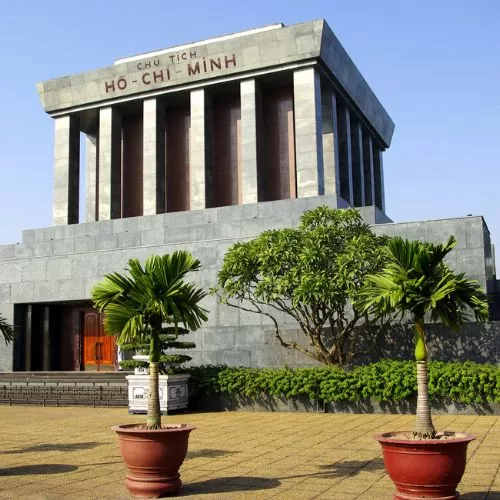
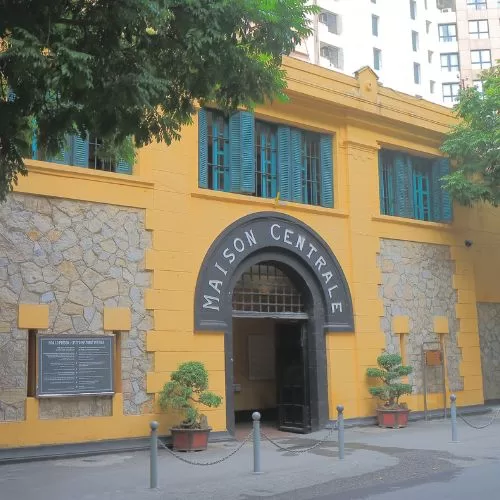
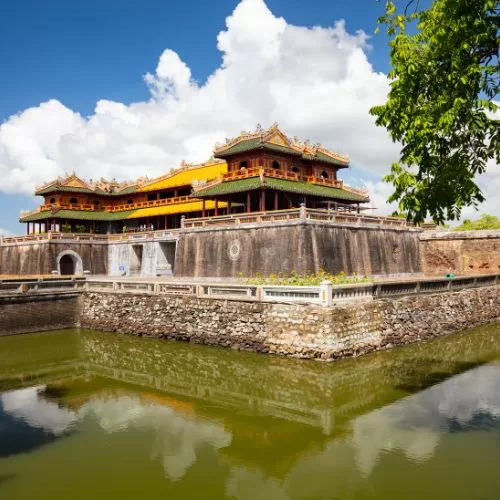
- Ho Chi Minh Mausoleum (Hanoi): Here you can learn more about Ho Chi Minh’s life and his significance in Vietnamese history. Ho Chi Minh is widely regarded as a visionary leader who played a pivotal role in shaping the course of Vietnam’s history. With his indomitable spirit and unwavering determination, Ho Chi Minh emerged as a revered figure, leading the Vietnamese people towards independence and self-determination. Ho Chi Minh’s embalmed body found its resting place in a glass coffin within Ho Chi Minh Mausoleum in Hanoi, a site that draws thousands of visitors annually.
- Hoa Lo Prison: When Vietnam was still a part of French Indochina, the French began constructing Hoa Lo Prison in 1896 and finished it in 1901. The prison was initially named Maison Centrale, which was a common euphemism for French prisons. The prison was used to lock up political prisoners fighting for independence in the war. After the French were driven out of Hanoi in 1954, the prison was converted into a Vietnamese facility.
- Hue Imperial Citadel: Hue Imperial Citadel was not only a military stronghold but also a cultural and political centre of Vietnam. The city served as the capital of Vietnam until 1945 when the country was divided into North and South Vietnam. The Hue Imperial Citadel or Hoang Thanh served as the residence of the emperors and the royal family, and the administrative centre of the royal court. It is also a significant site of worship for ancestors and the late emperors of the Nguyen Dynasty.
- My Son Sanctuary: During the 4th to 13th centuries there was a unique culture on the coast of contemporary Vietnam, owing its spiritual origins to the Hinduism of India. The property is located in the mountainous border Duy Xuyen District of Quang Nam Province, in central Vietnam. The My Son Sanctuary is a remarkable architectural ensemble that developed over ten centuries. It presents a vivid picture of spiritual and political life in an important phase of the history of South-East Asia.
The Best Time to Visit North Vietnam
The best time to visit North Vietnam varies depending on your chosen destinations and experiences. If you are planning to visit locations throughout Vietnam, then the best times to go are January through April or October and November. This allows you to enjoy the best weather that Vietnam has to offer. You can avoid the heaviest rains and the most extreme temperatures.
Local holidays should also be considered and the biggest nationwide holiday to consider is the new year, or Tet. Tet is celebrated on different dates according to the local calendar but falls in January or February.
In the mountainous north, avoiding colder temperatures is something to consider. To get the best temperatures and avoid the heaviest precipitation, the best time of year to visit this region is either in October and November or in March and April. The temperatures are colder in December and January, and the wet season arrives after April.
The rest of Northern Vietnam has lower elevations and temperatures can be much warmer, however, precipitation should be considered when planning a trip to Hanoi or the surrounding region. The best time of the year to visit Vietnam around Hanoi and the lower elevations of the north is October and November. For drier weather and the best temperatures, this time of year offers a nice combination.
Essential Travel Toolkit
🚖 Rideshare Apps – The most complete guide to Rideshare, Ride-hailing and taxis in Southeast Asia.
🚞 12Go.com – The easiest way to book transport, public or private in Southeast Asia, Japan and Beyond.
🏨 Trip.com – Consistently great accommodation and hotel deals.
🛩️ Trip.com – Get the best flight deals.
🚙 Trip.com – Find your perfect rental car.
🗺️ Getyourguide.com – Looking for an amazing local guide or tour. Get Your Guide will have something for everyone.
🗺️ Viator.com – Easily book tours and experiences at the lowest rate. Amazing options all over the world.
👨💻 NordVPN.com – Reliable VPN service that is guaranteed to keep you and your data safe anywhere in the world.
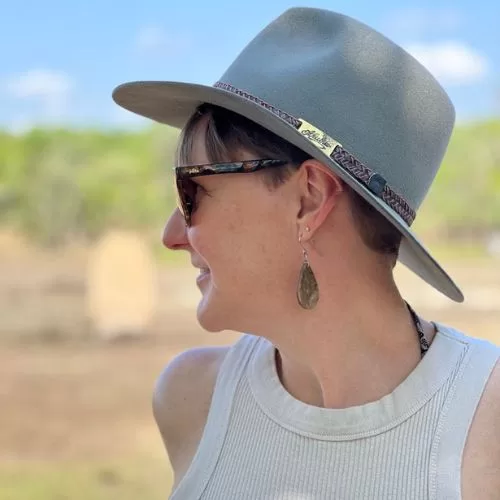
Wendy is a traveller, writer, and photographer with an insatiable curiosity for the world. Her journey, spanning South Africa, the UK, and now Australia, infuses her work with a rich tapestry of experiences. Join her on Getting Lost Again as she shares her creative perspective and passion for overland travel alongside Dan.

